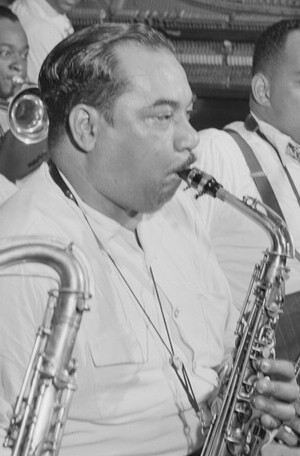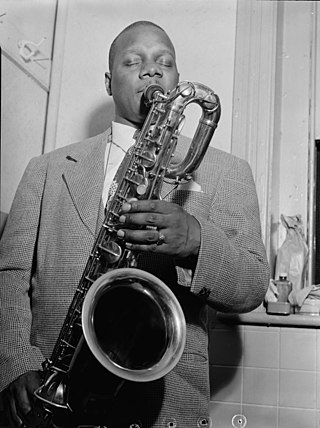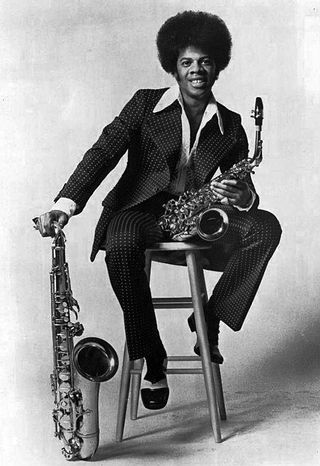Related Research Articles

A big band or jazz orchestra is a type of musical ensemble of jazz music that usually consists of ten or more musicians with four sections: saxophones, trumpets, trombones, and a rhythm section. Big bands originated during the early 1910s and dominated jazz in the early 1940s when swing was most popular. The term "big band" is also used to describe a genre of music, although this was not the only style of music played by big bands.

Omer Victor Simeon was an American jazz clarinetist. He also played soprano, alto, and baritone saxophone and bass clarinet.

Harry Howell Carney was a jazz saxophonist and clarinettist who spent over four decades as a member of the Duke Ellington Orchestra. He played a variety of instruments, but primarily used the baritone saxophone, being a critical influence on the instrument in jazz.

A multi-instrumentalist is a musician who plays two or more musical instruments, often but not exclusively at a professional level of proficiency.

Aaron Sachs was an American jazz saxophone and clarinet player.
Harry Roy was a British dance band leader and clarinet player from the 1920s to the 1960s. He performed several songs with suggestive lyrics, including "My Girl's Pussy" (1931), and "She Had to Go and Lose It at the Astor" (1939) and "When Can I have a Banana Again?" (1943)

John Fraser MacPherson CM was a Canadian jazz musician from Saint Boniface, Manitoba.

Jesper Thilo is a Danish jazz musician, mainly known as a tenor saxophonist, alto saxophonist and clarinetist. He is considered to be one of the top European straight-ahead jazz musicians of the post-1970 period. Ben Webster and Coleman Hawkins were early influences, while he later developed a highly personal sound reminiscent of Zoot Sims.

Ernesto Caceres was an American jazz saxophonist born in Rockport, Texas. He was a member of the Glenn Miller Orchestra from 1940 to 1942.
Jay Cameron was an American jazz reed musician who played the bass clarinet, baritone saxophone, and B-flat clarinet.
David Pell was an American jazz saxophonist, bandleader and record producer. He was best known for leading a cool jazz octet in the 1950s.
Harold Klein was an English jazz saxophonist. As a session musician, he played on recordings by the Beatles.
Frank Haywood Henry was an American jazz baritone saxophonist. In 1978 he was induced into the Alabama Jazz Hall of Fame.

Art Christmas was a Canadian dance band and jazz musician. For many years during the exciting dance band and jazz era of the 1920s, 1930s and 1940s, Art Christmas was often said to be Britain's leading saxophone player and multi-instrumentalist. In the 1930s and 1940s, young musicians in their teens and early twenties would follow Art all over Britain listening to him play and trying to copy his style, especially on alto saxophone.

Don Raffell was an American saxophonist, woodwind doubler (multireedist), studio musician and educator. Raffell recorded on hundreds of records, movies, and T.V shows dating from the 1940s all the way through the 1990s. His career as a studio musician was long and stylistically diverse having started in the big band era and playing all the way up through rock n' roll and other modern pop era acts. He had a long time close professional association with arranger and conductor Nelson Riddle.
LeRoy Watts Harris Jr. was an American jazz reedist. He was the son of Leroy Harris Sr., and his uncle was Arville Harris.
Clifford "King" Solomon was an American jazz and R&B musician.
Sidney Millward was a British musician who led the comedy band Sid Millward and His Nitwits, performing burlesques of classical music from the 1930s until the 1970s.
Peter Cavanagh was an English comic impressionist, popular on BBC radio in the 1940s and 1950s when he was known as "The Voice of Them All".

Gene Fred Cipriano, known familiarly as "Cip", was an American woodwindist and session musician, playing clarinet, oboe, flute and saxophone among other instruments. He played on hundreds of recording sessions, possibly more than any other woodwind musician.
References
- 1 2 3 Roy Hudd and Philip Hindin, Roy Hudd's Cavalcade of Variety Acts, Robson Books, 1998, ISBN 1-86105-206-5, p.36
- 1 2 Richard Anthony Baker, Old Time Variety: an illustrated history, Pen & Sword, 2011, ISBN 978-1-78340-066-9, pp.115-116
- ↑ Michael Kilgarriff, Grace, Beauty and Banjos: Peculiar Lives and Strange Times of Music Hall and Variety Artistes, Oberon Books, 1998, ISBN 1-84002-116-0, pp.83-84
- ↑ "Harry Hines", Crescendo, June 1971, p.3